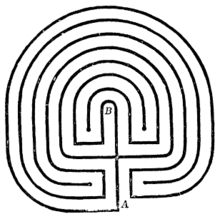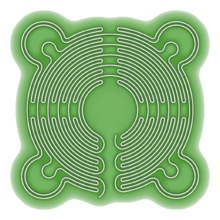Lawn maze
A lawn maze is a large, accessible labyrinth that has been cut into a lawn. There are also the Troy castles made of stones and carved into the rock, as well as modern mazes , the latter not being the equivalent of the lawn maze.

description
Most of the plants are rounded. The area of the historical facilities is up to 800 m². Lawn labyrinths are known from the British Isles, Germany and the northern Baltic region. Written evidence began in the 17th century. Most of the facilities were destroyed. Ten have survived in Great Britain and four in Germany, some of which have been reconstructed.
meaning
Like hedge labyrinths, lawn labyrinths probably go back to the "Chemin de Jerusalem". According to the Christian understanding, they symbolized the pilgrimage to Jerusalem and the path of the human soul to salvation . Walking through a labyrinth could replace a pilgrimage , the believers slid along the paths on their knees in repentance. According to other interpretations, they were prehistoric old Germanic places of worship. A distinction is made between different labyrinth shapes. Forms that are based on archaeologically proven stone circles are referred to as pre-Christian or prehistoric, while the classic , Cretan or Chartres type is linked to the legend of Theseus and the Minotaur .
Historic lawn labyrinths
Germany
- Eberswalde
- Graitschen auf der Höhe ( Thuringia ): "Schwedenhügel", classic pattern with eleven passages
- Steigra ( Saxony-Anhalt ): "Schwedenhügel", eleven passages
- Teresendorf in the Oderbruch

Great Britain
A list of English lawn mazes was published by William Moy Stratton Russell (1925-2006) and Claire Russell. Accordingly, around 40 historical turf labyrinths are known, of which over ten have been preserved.
- Alkborough ( North Lincolnshire ): " Julian's Bower ", Christian pattern, eleven whorls
- Bougthon Green (Northamptonshire), mentioned as early as 1353, destroyed in the First World War
- Breamore ( Hampshire ): "Mizmaze", Christian pattern, eleven whorls
- Chilcomb (Hampshire), renovated in the mid-19th century
- Comberton Mazles, destroyed.
- Gloddaeth , Wales. Established in the 16th century, destroyed in the middle of the 19th century
- Hilton ( Huntingdonshire ): "Hilton Maze", nine whorls. According to the inscription on the stone, decorated by William Sparrow in 1660; In the neighboring town of Comberton there was a similar, much older system called "the Mazles", which has not been preserved
- Lawn maze in Saffron Walden ( Essex ): "Town Maze", 17 walkways, four corner bastions ("ears")
- Skewsby , ( North Yorkshire ): " City of Troy ", classic pattern, seven whorls
- Somerton ( Oxfordshire ): "Troy Town", classic pattern, 15 whorls
- Troy Town Maze from St Agnes Isles of Scilly; the work of a lighthouse keeper of the 1790s
- Winchester ( Hampshire ): “St. Catherine's Hill “, Christian pattern, nine whorls, square
- Lawn maze by Wing ( Rutland ): "Wing Maze", eleven passages
Ireland
Conleth Manning names three lawn mazes in Ireland, but only one of them is secured.
- Ballynavortha, Walls of Troy in County Wicklow

Reconstructions
Many new lawn mazes have been created since the 1980s. These are both replicas of existing ones, e.g. T. historically proven patterns as well as new creations.
Germany
- Bad Grönenbach (Unterallgäu): seven passages
- Bad Kissingen (Bavaria): Luitpoldpark , seven passages
- Lawn labyrinth Eilenriede ( Lower Saxony ): "The wheel", nine passages (1932), based on a historical model
- Kaltental (Ostallgäu): Aufkirch , seven passages
- Kaufbeuren (Bavaria): Jordan Park with eleven passages
- Gützer Berg (near Landsberg, Saxony-Anhalt): eleven whorls
Austria
- Schweiggers (Lower Austria): at Möldershöf on the Thaya spring
Great Britain
- Bath (Somerset): Beazer Gardens, ellipse, seven whorls, a mosaic in the center (1984)
- Cambridge University Botanical Garden : It has a double spiral shape and is planted with the New Zealand grass, Anemanthele lessoniana .
- Earth Labyrinth, Galloway Forest , Dumfriesshire . Built in 1990 by Jim Buchannan
- Archbishop's Maze in Grays Court at Henley-on-Thames in the Chilterns . It was designed by Adrian Fisher in 1980 and describes the pilgrimage to Jerusalem or man's way of life and his eventual salvation. The seven whorls symbolize the seven days of creation . Further symbolism of numbers can be found in the length of the cross arms: 33 ', the age of Jesus at his crucifixion. The ratio between the diameter of the center and the distance between the walkways is nine and recalls the ninth hour, the agony of Christ. Diameter 25 m, length 402 m (1/4 mile ). The labyrinth is made of 4,500 bricks and set into a low lawn. In the center is a gold-plated sundial, which symbolizes the light of the world.
- Kerscot, Swimbridge ( Devon ), diameter 5.4 m, with a slab in the center with a quote from TS Eliot : "At the still point of the turning world" ( Four Quartets , Burnt Norton)
- Maureen's Mump Labyrinth in Crackington Haven , Cornwall, is an April Fool's joke .
- Dower House, Morville , Shropshire, designed by Katherine Swift with varying lawn heights
- Earth and Wildflower Maze, Tapton Park , Chesterfield , built in 1996 by Jim Buchannan on behalf of the Land Art Commission . Length of the passage 2.4 km
- Willen Park (Milton Keynes), greatly enlarged imitation of the Saffron Walden lawn maze with a path length of over three kilometers
- Seaton (Devon)
Ireland
- Glendalough , Co. Wicklow Visitor Center
- Fox Covert in the Little Curragh, Co. Kildare
literature
- Robert Field: Mazes, ancient and modern. Stradbroke 1999, Chapter 2, pp. 10-21.
- Jeff Saward: Labyrinths and mazes. The definitive guide to ancient and modern traditions. London, Gaia 2003, pp. 118-136. ISBN 1-85675-183-X .
- Joergen Thordrup: All tiders labyrinter. Silkeborg 2002, pp. 67-71.
- Richard Cavendish: Prehistoric England . English Tourist Board, Guild Publishing London 1983, p. 127.
Individual evidence
- ^ Penelope Hobhouse, 1986, p. 44
- ^ The Prehistoric Sites of Great Britain , compilation in English with an overview map
- ^ WMS Russell / C. Russell 1991, pp. 77-88
- ^ WMS Russell / C. Russell 1991, 77
- ↑ a b c W. MS Russell / C. Russell 1991, 88
- ↑ Jeff Saward, Maureen's Mump. Folklore 105, 1994, 109
- ↑ Richard Haslam 2006, Bodysgallen: A Renaissance Garden Survival? Garden History 34, No. 1, 136
- ^ Conleth Manning 2004, pp. 166-168
- ↑ The Eilenriede. Europe's most important urban forest in the heart of Hanover has a lot to offer. In: hannover.de . State capital Hanover , p. 27 , accessed on January 17, 2018 .
- ^ University Botanic Garden, Cambridge: Gardens & Plantings: Grass Maze
- ↑ a b Guy Cooper / Gordon Taylor 2001, p. 178
- ↑ Penelope Hobhouse, 1986, pp. 45-46
- ↑ Guy Cooper / Gordon Taylor 2001, p. 149
- ↑ Jeff Saward, Maureen's Mump. Folklore 105, 1994, 109
- ↑ Helen Attlee, Morville Magic, The English Garden Jan 2013, 53
- ↑ a b Conleth Manning 2004, p. 166
See also
Web links
- 100 labyrinths (private website by Sven Bott, Flörsheim-Dalsheim)
- mymaze.de: Photos of existing lawn labyrinths in the photo gallery
literature
- Guy Cooper / Gordon Taylor: The curious Gardener , London, Headline 2001
- Penelope Hobhouse, The National Trust: A Book of Gardening. Ideas - Methods - Designs. A practical guide. London, Pavilion, Michael Joseph 1986
- Conleth Manning 2004: A former Sod or Turf Maze at Ballynavortha , Co. Wicklow. Journal of the Royal Society of Antiquaries of Ireland 134, 2004
- WH Matthews: Mazes and Labyrinths , London 1922 , online version
- WMS Russell / C. Russell: English Turf Mazes, Troy, and the Labyrinth. Folklore 102/1, 1991


